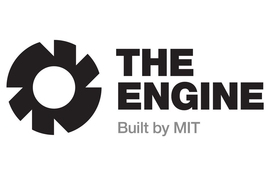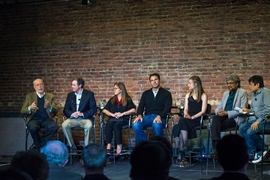At a community forum on MIT’s new startup accelerator, The Engine, administrators discussed the new enterprise and fielded questions about its formation, components, mission, funding, mentor and equipment access, startup-selection process, and other issues.
The forum, held last night in Building 32, opened with remarks from MIT’s leadership who helped launch The Engine: MIT President L. Rafael Reif, professor and head of the Department of Electrical Engineering and Computer Science Anantha Chandrakasan, Provost Martin Schmidt, and Executive Vice President and Treasurer Israel Ruiz.
The floor then opened up to professors, students, alumni, and other MIT community members, who posed questions about The Engine’s selection process and components, and offered advice and potential opportunities for collaboration.
Announced in October, The Engine is a new venture aimed at supporting entrepreneurs pursuing transformative technologies that are capital- and time-intensive. The venture aims to provide those entrepreneurs hundreds of millions of dollars in funding, and make available hundreds of thousands of square feet of space in Kendall Square and nearby communities. A web-based app, called the Engine Room, will allow entrepreneurs to use or rent specialized resources from MIT, and participating companies and institutions, including office and conference spaces on and off campus, clean rooms, and other facilities and specialized equipment. The venture will also introduce entrepreneurs to peers, mentors, and established companies in innovation clusters across the region and around the world.
Within a day following the announcement, The Engine’s website received about a thousand inquiries from those wanting to become involved. In February, The Engine will host a forum for startups that have submitted or plan to submit applications to discuss the program and selection process in more detail. In the spring, The Engine program will formally be kicked off and the first startups will enter the accelerator.
Making The Engine
In his opening remarks, President Reif laid out key reasons why MIT launched The Engine. One is to provide “patient” capital to entrepreneurs developing transformative technologies, who sometimes have difficulty finding funding; another is to help keep startups in the region. A third reason, he added, is to set successful examples for aspiring entrepreneurs in developing transformative technologies.
“Many students at MIT that are interested in [pursuing] these ideas in science-based innovation see that ideas like theirs don’t make it through, because there’s no patient capital,” he said. “We’d like those ideas to have a path for success to the marketplace to inspire others that want to do something similar.”
Ruiz recalled the term “innovation orchard” from President Reif’s May 2015 op-ed in The Washington Post. The piece discussed how supporters of innovation from the public, for-profit, and nonprofit sectors could form coalitions to provide physical space, mentorship, and bridge funding to transformative startups, to support their transition from idea to investment.
In creating MIT’s “innovation orchard,” Ruiz said, the Institute considered several realities: transformative-technology startups at MIT didn’t have a lot of early-stage resources; venture capital funding was focusing increasingly on shorter timeframes, higher valuations, and higher expectations on returns; and most MIT and local entrepreneurs had to head to the West Coast for find support. “We wanted to think about how we could … say, ‘Yes, there are the same opportunities here at MIT,’” Ruiz said, referencing the final point.
Chandrakasan introduced the Engine Room app and discussed how The Engine will work collaboratively with MIT’s existing innovation programs to address issues with funding, scaling up, equipment usage, forming founding teams, and other matters.
In selecting startups, Chandrakasan added, The Engine’s evaluation committee will consist of experts from outside MIT to avoid any conflicts of interest. “It’s also worth pointing out that funding for this, the investors, will be those who are committed to patient capital and/or seeing regional growth,” he said.
Schmidt introduced several ad hoc working groups formed for The Engine, “which are going to be structured to look at some of the key pieces that are critical to the success of people from our campus community exercising and using The Engine and the Engine Room.”
The committees are: the Engine Advisory Committee, led by Chandrakasan and populated by the leaders of each other group; the Facilities Access Working Group, led by Martin Culpepper, a professor of mechanical engineering and the “maker czar” for MIT; the Technology Licensing Working Group, led by Tim Swager, the John D. MacArthur Professor of Chemistry; the Conflict of Interest Working Group, led by Klavs Jensen, a professor of chemical engineering; the Visas for Entrepreneurs Working Group, led by Dick Yue, the Philip J. Solondz Professor of Engineering; and MIT’s Innovation Ecosystem Working Group, led by MIT Innovation Initiative co-directors Fiona Murray, who is the William Porter (1967) Professor of Entrepreneurship at MIT Sloan School of Management, and Vladimir Bulovic, the Fariborz Maseeh (1990) Professor of Emerging Technology.
Addressing community needs
After remarks, Ruiz and Chandrakasan fielded questions from more than a dozen MIT community members, including entrepreneurs, students, professors, and representatives of organizations and startup incubators in the region.
Answers to many questions shed light on The Engine’s components and selection process. For example, digital resources, such as CAD and other software for hardware design, will most likely be offered through the equipment-sharing program; there are no current restrictions on the types of startups accepted into the accelerator; The Engine plans to begin talks about potential collaborations with local incubators, such as Greentown Labs; and coordinated events will connect engineering students with MIT Sloan students, other entrepreneurs, and mentors.
One commenter asked if The Engine would support clinical trials for medical-device startups, a key startup category along with biotechnology, robotics, manufacturing, and energy. Ruiz noted MIT has strong existing partnerships with Boston hospitals, which could help startups transition more easily into clinical trials. But, he added, the venture only aims to carry startups through early stages. “At some point, The Engine will not carry you through clinical trials, but we will facilitate early on [resources for] the development, which is the most crucial aspect,” Ruiz said.
An alumna from the MIT Media Lab who founded an education-hardware startup asked if there was a place in The Engine for startups that may not turn much profit, even in the long-run. Noting that the question is very important, Ruiz said, “There’s one word that drives MIT and that we want to translate into The Engine: ‘impact.’ The Engine would indeed be interested in, say, low-cost diagnostic technologies for developing countries, that don’t generate much profit. Certainly, we’re interested in social entrepreneurs with the opportunity to create a much wider impact.”
A few commenters offered advice and opportunities for collaboration with The Engine. MIT Sloan alumnus Peter Rothstein, now president of the Northeast Clean Energy Council, which works with startup incubators across the region, said his organization could discuss collaborating with The Engine on shared equipment, mentorship, and other resources. His recommendation for administrators was to form committees designated for facilitating partnerships with investors, industry, customers, and other incubators.
“Great ideas,” Chandrakasan replied. “That’s exactly the type of things we’re thinking about.”










